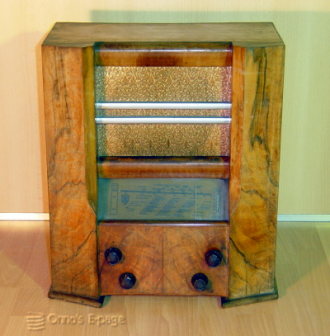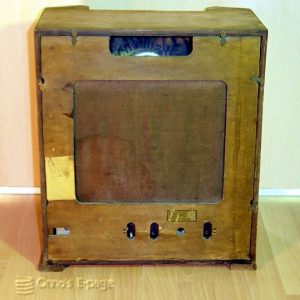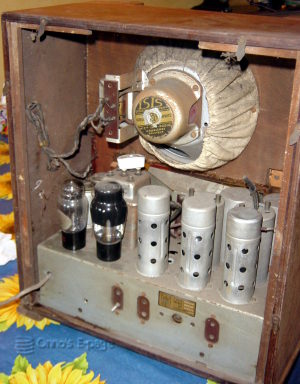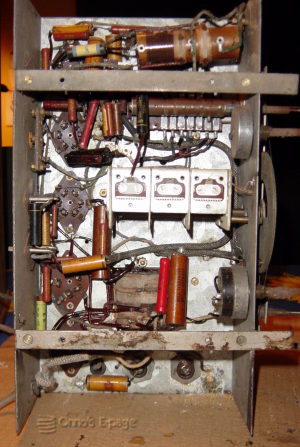Isis 127A (1937)

The Isis 127A is a Belgian radio from around 1937.
It comes in a "tombstone" model wooden case.
It uses American valves and it is solidly built.
In July 2006 I came across an advertisement for this radio on an auction site.
I found it interesting because it looked different, and really old.
Much to my surprise, the price did not go very high.
This may be because Isis has only been a small brand that is not very well
known among collectors.
On the downside is that I could hardly find any documentation on the
manufacturer and none on this specific model.
The Isis model 127A has MW, LW and one SW range.
It is a rather common superhet with a low IF.
(I tested one IF transformer and found a resonance frequency of 115 kHz.)
It has been solidly built, and the technology is a bit conservative.
It has an electrodynamic speaker, the field coil being used as a choke.
The chassis is built from solid steel.
The coils are well shielded by large aluminum cylinders.
All 3 HF valves are also shielded.
The triple ganged tuning capacitor has been mounted on a subassembly together
with the tuning dial and tuning mechanism.
The subassembly was suspended by rubber spacers.
Unfortunately, the rubber has dried out and crumbled years ago.
All the valves are American types on UX bases:
| 6A7 | (Tungsram) octode frequency changer, UX7 base |
| 6D6 | (Tungsram) penthode IF amplifier, UX6 base |
| 75 | (Tungsram) diode plus triode, UX6 base |
| 47 | (Tungsram) directly heated output pentode , UX5 base |
| 80 | (RCA) rectifier, UX4 base |
The usage of a directly heated valve as output amplifier is a bit odd.
But all the sockets look original, so I assume these are the original types.
The design is classy, but a bit old-fashioned.
The case is higher than it is wide ("tombstone" format).
The walnut veneer must have been beautiful but it is a bit weathered.
The knobs are really nice: they have the "Isis" brand embossed.
The Isis logo returns on the tuning dial, that is made of celluloid.
The radio looks like much of it has been hand made.
Even the stickers on the back with the type number and serial number
are hand-written.
Isis was a smaller Belgian radio brand, in the city of Charleroi.
There are not many Isis models documented on the Internet.
Even the
Swiss Radiomuseum
site only mentions two other Isis models.
I could not yet find service documentation on this model.
In the limited Belgian reference books I have, I can find similar models
by other brands
using a comparable set of valves but not an exactly identical design.
In september 2008, I met some people from the
VLHR,
who had a folder from 1937 laying out the Isis model range.
In this range the 127A is positioned under the 128A, which is the most luxurious model.
The radio did not look too well when the mail brought it.
The varnish (probably French polish) on the sides has all but vanished,
like it has been standing in the rain.
On the front and top, the varnish looks better.
The veneer is cracked an weathered, but it can be revarnished, I trust.
This radio urgently needed attention when I received it.
It had been lying on its back in the mail parcel,
and the wet electrolytics had leaked.
There were stripes of brown liquid on the back panel.
I cleaned everything with a wet cloth with a little drop of detergent.
Then I took out the frame and removed some crusts of dried up electrolytic
and some rust from the bottom of the case.
Apperently, the electrolytics had been leaking before.
I was lucky to prevent further damage from this last leakage.
While I was at it, I thoroughly cleaned the case with the vacuum cleaner
and inspected the frame.
The frame is only slightly rusty.
Most of the electronics were looking good, except for
the power transformer.
It has its outer windings exposed, and these windings are corroded.
This may cause leakage currents when I will try the radio.
So this radio will be a serious challenge.
I think I will have to redo the French polish and I hope I can
fix the electronics, too.






